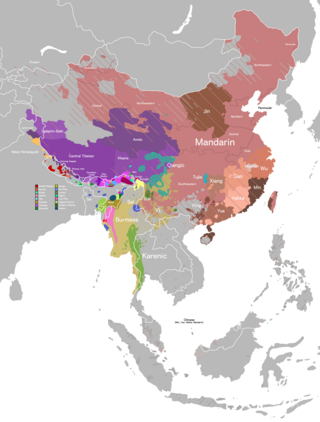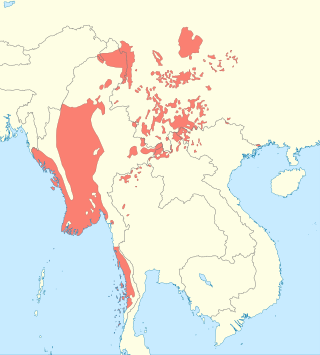Related Research Articles

Sino-Tibetan is a family of more than 400 languages, second only to Indo-European in number of native speakers. Around 1.4 billion people speak a Sino-Tibetan language. The vast majority of these are the 1.3 billion native speakers of Sinitic languages. Other Sino-Tibetan languages with large numbers of speakers include Burmese and the Tibetic languages. Four United Nations member states have a Sino-Tibetan language as their main native language. Other languages of the family are spoken in the Himalayas, the Southeast Asian Massif, and the eastern edge of the Tibetan Plateau. Most of these have small speech communities in remote mountain areas, and as such are poorly documented.

Old Chinese, also called Archaic Chinese in older works, is the oldest attested stage of Chinese, and the ancestor of all modern varieties of Chinese. The earliest examples of Chinese are divinatory inscriptions on oracle bones from around 1250 BC, in the Late Shang period. Bronze inscriptions became plentiful during the following Zhou dynasty. The latter part of the Zhou period saw a flowering of literature, including classical works such as the Analects, the Mencius, and the Zuo Zhuan. These works served as models for Literary Chinese, which remained the written standard until the early twentieth century, thus preserving the vocabulary and grammar of late Old Chinese.
Historical Chinese phonology deals with reconstructing the sounds of Chinese from the past. As Chinese is written with logographic characters, not alphabetic or syllabary, the methods employed in Historical Chinese phonology differ considerably from those employed in, for example, Indo-European linguistics; reconstruction is more difficult because, unlike Indo-European languages, no phonetic spellings were used.
The Kiranti languages are a major family of Sino-Tibetan languages spoken in Nepal and India by the Kirati people.

The Lolo-Burmese languages of Burma and Southern China form a coherent branch of the Sino-Tibetan family.
The Burmish languages are a subgroup of the Sino-Tibetan languages consisting of Burmese as well as non-literary languages spoken across Myanmar and South China such as Achang, Lhao Vo, Lashi, and Zaiwa.

The Tibeto-Burman languages are the non-Sinitic members of the Sino-Tibetan language family, over 400 of which are spoken throughout the Southeast Asian Massif ("Zomia") as well as parts of East Asia and South Asia. Around 60 million people speak Tibeto-Burman languages. The name derives from the most widely spoken of these languages, Burmese and the Tibetic languages, which also have extensive literary traditions, dating from the 12th and 7th centuries respectively. Most of the other languages are spoken by much smaller communities, and many of them have not been described in detail.
Sino-Austronesian or Sino-Tibetan-Austronesian is a proposed language family suggested by Laurent Sagart in 1990. Using reconstructions of Old Chinese, Sagart argued that the Austronesian languages are related to the Sinitic languages phonologically, lexically and morphologically. Sagart later accepted the Sino-Tibetan languages as a valid group and extended his proposal to include the rest of Sino-Tibetan. He also placed the Tai–Kadai languages within the Austronesian family as a sister branch of Malayo-Polynesian. The proposal has been largely rejected by other linguists who argue that the similarities between Austronesian and Sino-Tibetan more likely arose from contact rather than being genetic.
Proto-Tai is the reconstructed proto-language of all the Tai languages, including modern Lao, Shan, Tai Lü, Tai Dam, Ahom, Northern Thai, Standard Thai, Bouyei, and Zhuang. The Proto-Tai language is not directly attested by any surviving texts, but has been reconstructed using the comparative method.
There have been various classification schemes for Southeast Asian languages.
Proto-Tibeto-Burman is the reconstructed ancestor of the Tibeto-Burman languages, that is, the Sino-Tibetan languages, except for Chinese. An initial reconstruction was produced by Paul K. Benedict and since refined by James Matisoff. Several other researchers argue that the Tibeto-Burman languages sans Chinese do not constitute a monophyletic group within Sino-Tibetan, and therefore that Proto-Tibeto-Burman was the same language as Proto-Sino-Tibetan.
Proto-Hmong–Mien (PHM), also known as Proto-Miao–Yao, is the reconstructed ancestor of the Hmong–Mien languages. Lower-level reconstructions include Proto-Hmongic and Proto-Mienic.
William Hubbard Baxter III is an American linguist specializing in the history of the Chinese language and best known for his work on the reconstruction on Old Chinese.
Scholars have attempted to reconstruct the phonology of Old Chinese from documentary evidence. Although the writing system does not describe sounds directly, shared phonetic components of the most ancient Chinese characters are believed to link words that were pronounced similarly at that time. The oldest surviving Chinese verse, in the Classic of Poetry (Shijing), shows which words rhymed in that period. Scholars have compared these bodies of contemporary evidence with the much later Middle Chinese reading pronunciations listed in the Qieyun rime dictionary published in 601 AD, though this falls short of a phonemic analysis. Supplementary evidence has been drawn from cognates in other Sino-Tibetan languages and in Min Chinese, which split off before the Middle Chinese period, Chinese transcriptions of foreign names, and early borrowings from and by neighbouring languages such as Hmong–Mien, Tai and Tocharian languages.
Scott DeLancey is an American linguist from the University of Oregon. His work focuses on typology and historical linguistics of Tibeto-Burman languages as well as North American indigenous languages such as the Penutian family, particularly the Klamath. His research is known for its diversity of its thematic and theoretical reach.
The Burmo-Qiangic or Eastern Tibeto-Burman languages are a proposed family of Sino-Tibetan languages spoken in Southwest China and Myanmar. It consists of the Lolo-Burmese and Qiangic branches, including the extinct Tangut language.

The Mainland Southeast Asia linguistic area is a sprachbund including languages of the Sino-Tibetan, Hmong–Mien, Kra–Dai, Austronesian and Austroasiatic families spoken in an area stretching from Thailand to China. Neighbouring languages across these families, though presumed unrelated, often have similar typological features, which are believed to have spread by diffusion. James Matisoff referred to this area as the "Sinosphere", contrasted with the "Indosphere", but viewed it as a zone of mutual influence in the ancient period.
Japhug is a Gyalrong language spoken in Barkam County, Rngaba, Sichuan, China, in the three townships of Gdong-brgyad, Gsar-rdzong and Da-tshang.
Although Old Chinese is known from written records beginning around 1200 BC, the logographic script provides much more indirect and partial information about the pronunciation of the language than alphabetic systems used elsewhere. Several authors have produced reconstructions of Old Chinese phonology, beginning with the Swedish sinologist Bernhard Karlgren in the 1940s and continuing to the present day. The method introduced by Karlgren is unique, comparing categories implied by ancient rhyming practice and the structure of Chinese characters with descriptions in medieval rhyme dictionaries, though more recent approaches have also incorporated other kinds of evidence.
Proto-Karenic or Proto-Karen is the reconstructed ancestor of the Karenic languages.
References
- 1 2 Benedict, Paul K. (1972), Sino-Tibetan: A Conspectus (PDF), Cambridge University Press, ISBN 978-0-521-08175-7.
- ↑ Sagart, Laurent; Jacques, Guillaume; Lai, Yunfan; Ryder, Robin J.; Thouzeau, Valentin; Greenhill, Simon J.; List, Johann-Mattis (6 May 2019). "Dated language phylogenies shed light on the ancestry of Sino-Tibetan". Proc. Natl. Acad. Sci. U.S.A. 116 (21): 10317–10322. Bibcode:2019PNAS..11610317S. doi: 10.1073/pnas.1817972116 . PMC 6534992 . PMID 31061123.
- ↑ Orlandi, Georg (2021). "Once again on the history and validity of the Sino-Tibetan bifurcate model". Journal of Language Relationship. 19 (4): 263–292.
- ↑ Hill 2019.
- ↑ van Driem, George (2007). "The diversity of the Tibeto-Burman language family and the linguistic ancestry of Chinese". Bulletin of Chinese Linguistics. 1 (2): 211–270. doi:10.1163/2405478X-90000023.
- ↑ Egerod, Søren Christian. "Sino-Tibetan languages - Linguistic characteristics". Encyclopædia Britannica Online . Retrieved 10 July 2019.
- ↑ Peiros, Ilia; Starostin, S.A. (1996). A comparative vocabulary of five Sino-Tibetan languages. Parkville, VIC: Univ. of Melbourne, Dept. of Linguistics and Applied Linguistics. ISBN 9780732513504.
- ↑ Hill 2019, p. 211.
- ↑ Hill 2019, p. 234-235.
- ↑ Hill 2019, p. 216.
- ↑ Gong Huangcheng (龔煌城) (2003). 從原始漢藏語到上古漢語以及原始藏緬語的韻母演變 [Final changes from Proto-Sino-Tibetan to Old Chinese and Proto-Tibeto-Burman](PDF). 古今通塞:漢語的歷史與發展. 第㆔屆國際漢學會議論文集語言組 (in Chinese). pp. 187–223. Archived from the original (PDF) on 2020-11-03. Retrieved 22 October 2023.
- ↑ Baxter, William H.; Sagart, Laurent. "The Baxter-Sagart reconstruction of Old Chinese". The Baxter-Sagart reconstruction of Old Chinese. Retrieved 10 August 2022.
- 1 2 Hill (2012).
